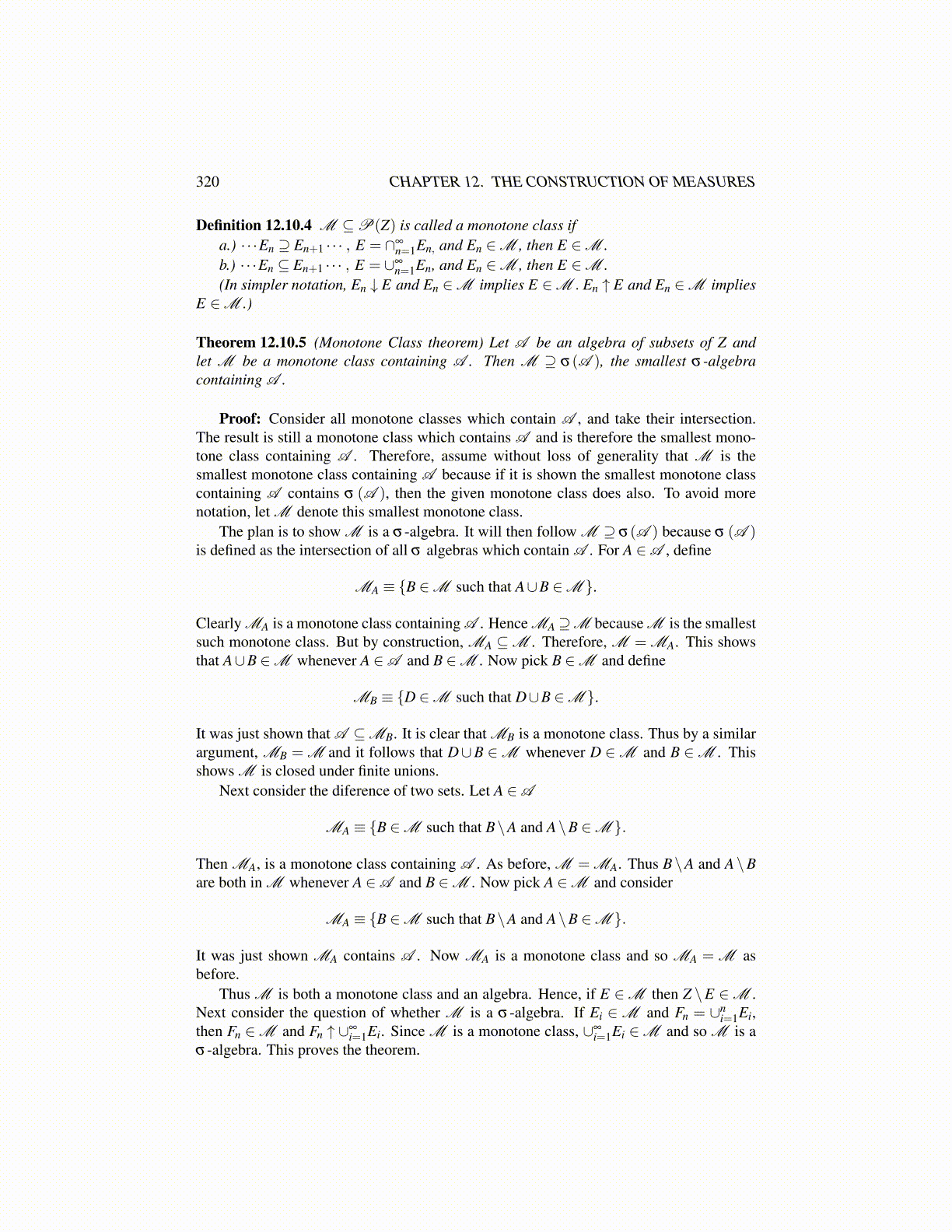
320 CHAPTER 12. THE CONSTRUCTION OF MEASURES
Definition 12.10.4 M ⊆P(Z) is called a monotone class ifa.) · · ·En ⊇ En+1 · · · , E = ∩∞
n=1En, and En ∈M , then E ∈M .b.) · · ·En ⊆ En+1 · · · , E = ∪∞
n=1En, and En ∈M , then E ∈M .(In simpler notation, En ↓ E and En ∈M implies E ∈M . En ↑ E and En ∈M implies
E ∈M .)
Theorem 12.10.5 (Monotone Class theorem) Let A be an algebra of subsets of Z andlet M be a monotone class containing A . Then M ⊇ σ(A ), the smallest σ -algebracontaining A .
Proof: Consider all monotone classes which contain A , and take their intersection.The result is still a monotone class which contains A and is therefore the smallest mono-tone class containing A . Therefore, assume without loss of generality that M is thesmallest monotone class containing A because if it is shown the smallest monotone classcontaining A contains σ (A ), then the given monotone class does also. To avoid morenotation, let M denote this smallest monotone class.
The plan is to show M is a σ -algebra. It will then follow M ⊇ σ(A ) because σ (A )is defined as the intersection of all σ algebras which contain A . For A ∈A , define
MA ≡ {B ∈M such that A∪B ∈M }.
Clearly MA is a monotone class containing A . Hence MA ⊇M because M is the smallestsuch monotone class. But by construction, MA ⊆M . Therefore, M = MA. This showsthat A∪B ∈M whenever A ∈A and B ∈M . Now pick B ∈M and define
MB ≡ {D ∈M such that D∪B ∈M }.
It was just shown that A ⊆MB. It is clear that MB is a monotone class. Thus by a similarargument, MB = M and it follows that D∪B ∈M whenever D ∈M and B ∈M . Thisshows M is closed under finite unions.
Next consider the diference of two sets. Let A ∈A
MA ≡ {B ∈M such that B\A and A\B ∈M }.
Then MA, is a monotone class containing A . As before, M = MA. Thus B\A and A\Bare both in M whenever A ∈A and B ∈M . Now pick A ∈M and consider
MA ≡ {B ∈M such that B\A and A\B ∈M }.
It was just shown MA contains A . Now MA is a monotone class and so MA = M asbefore.
Thus M is both a monotone class and an algebra. Hence, if E ∈M then Z \E ∈M .Next consider the question of whether M is a σ -algebra. If Ei ∈M and Fn = ∪n
i=1Ei,then Fn ∈M and Fn ↑ ∪∞
i=1Ei. Since M is a monotone class, ∪∞i=1Ei ∈M and so M is a
σ -algebra. This proves the theorem.